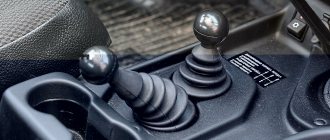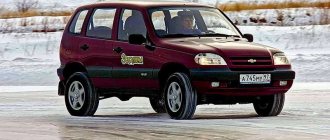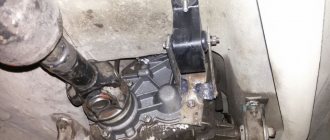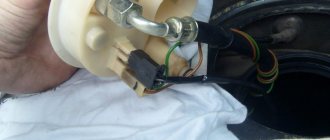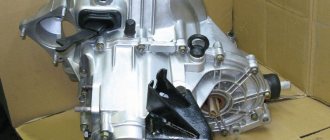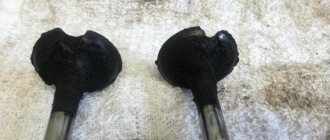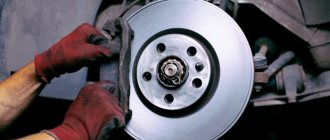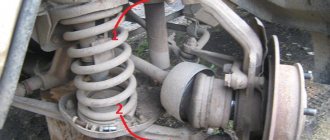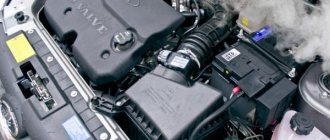Transfer case, "transfer case". Repair, malfunctions +
Transfer case, "transfer case". Repair, malfunctions +
Post by Anton » April 16, 2010, 04:46 pm
Re: Transfer case repair.
Post by Janet » 02 Jul 2010, 13:26
A simple question: to change the bearing of the rear axle drive shaft, do you need to shake up the entire box or is it possible to somehow get to it from the outside?
Something like this, if the memory hasn’t distorted anything.
Transfer case, "transfer case".
Post by hpionodav » 25 Aug 2010, 21:07
GAR: The 3rd pillar of the Republic of Kazakhstan is helping. But then the floor shakes along with the transfer case on 3 supports.
It is necessary to treat the cause, not the effect, and if it doesn’t interfere, hammer it and drive. I had vibrations in my new field from the very beginning.
Judging by the fact that I don’t understand what we’re talking about, no
Some kind of knowledgeable person sorted it out, adjusted something there and said that the pillows would need to be changed!
Help with handout
Post by Denka » Aug 28, 2010, 04:54 pm
I’m not from here, an inexperienced driver, please explain, when I turn on the lock and drive out onto the asphalt, the rear wheels start to jerk, lock and slip with a whistle, it’s impossible to accelerate, the car jerks when I’m driving on a country road, everything seems to be normal. and even after that I can’t turn off the transfer case, the handle remains in one position and it’s impossible to turn it off! You have to remove the rear crankshaft and drive like this until by some miracle it (the handle) starts working. What could it be?
I’ve had the car for 3 months, I bought it and I don’t know what the old owner did with it. As for reversing: the car drives 5-10 meters and with an incomprehensible sound gets up and doesn’t go back any more, we tried, of course, forward and backward, and nothing! I also have the right bracket for attaching the front axle to the power unit (the gusset) has burst, and the front axle is moving up and down and back and forth. Maybe this is the problem? + The right CV joint also crunches, in short the whole front end is damaged. There was no money, now it has appeared, and now I’m thinking, it can’t be in the rear axle? exactly in the distribution box. or because of the ear mount?
- I think it looks like a box, but I could be wrong.
why does the handle stick?
Igor: The handle sticks because it hasn’t been used for a hundred years, the same thing happens to me when I rarely turn it on. Driving on saflt with a low road block, that’s how I finished off the front axle
Unlocking option: If you turned on the lock when moving forward, then turn on the rear and start moving backward while pushing the lock lever forward. If it doesn’t help, then you roll forward and backward, pushing the lever forward. If the bracket on the bridge is cracked, then you must weld it or replace it, otherwise you will rip the studs out of the RPM body.
Re: Help with transfer case
Post by arty » Oct 20, 2010, 10:02 pm
can you talk about this in more detail? I have a Niva 93g. 4 speed which means in the distribution 4.1. Question: do GP differentials differ by year? And it also means that with my 29″ transfer case it won’t be particularly difficult for her to turn the wheels? or look for an old lady with 4.3
MEW: Who will do the repairs, after about 2000 they began installing gears with a 2.25 module instead of 2.5, that is, a larger number of teeth with approximately the same gear diameter. When I disassembled the rk, I calculated: Drive shaft: each gear separately: high 39\lowered 29 Intermediate shaft (both gears are made at the same time): high 32\lowered 42, 32 teeth contact with the differential gear. Differential gear: 47. I can’t say anything about the old ones, I didn’t have a chance to disassemble them. Apparently there is nothing to break with standard RCs other than the wear of the satellite washers. Captain: arty,
Gear ratios of the RK from FAK on Niva4x4: 1.2 2.123 or 1.2 2.135 Gear ratios of the small-module RK, if MEW is not mistaken: 47/39=1.205 47/32*42/29=2.127
Re: Transfer case, "transfer case".
Post by Vlad_aka_SoHm » 22 Oct 2010, 15:00
Re: Transfer case, "transfer case".
Post by andzeru » Oct 26, 2010, 10:20 pm
Guys, I want to talk about the transfer case, this is my first car from the domestic auto industry, so I don’t know anything about it, honestly, the quality of the car leaves much to be desired. But to the problem: in 3rd, 4th, 5th gears a whistle appears, it seems like it’s coming from the gearbox or the gearbox, I checked it in all modes, it disappears in neutral, I changed the oil in the gearbox and filled the gearbox with TNK 80W90, the sound became less intense, but remained. As I understand it, most likely some bearing in the Republic of Kazakhstan is making noise, tell me what is the problem and what does this threaten? Niva 21310 2006, I've been driving like this for 3 weeks, I've driven 1 thousand.
Re: Transfer case, "transfer case".
Post by bo0r » 01 Dec 2010, 20:06
Re: Transfer case, "transfer case".
Post by ABUU » 02 Dec 2010, 20:41
Gentlemen, forum members, good day. Who can explain to the teapot
, while driving, when hitting large irregularities (speed bump, hole, etc.), it periodically knocks out the transfer case (Become in a neutral position)
Captain: see if the lever touches the hole in the floor? In general, this jamb (shutdown) is often encountered on M-s, maybe we should strain the warranty?
Already stressed, today I went to the warranty office and they said we’ll replace the entire transfer case, they didn’t even look
Source
Auto service gear reducer
The hum and whine of a gearbox is its most common malfunction.
There are four main causes of gearbox hum, here they are presented in descending order of prevalence:
1. Wear of the main pair
2. Bearing wear
3. Unscrewed shank nut
4. Incorrect adjustment
Each of the listed reasons for the occurrence of hum is characterized by its own character of the hum and the mode of movement in which it occurs.
But first of all, if the gearbox begins to hum, then there is no chance of saving it using unconventional methods ( treating it with an additive, pouring thicker oil, pouring molybdenum or sawdust into the oil, etc.). The cause of the hum is wear of either the main pair or the bearings. It is not possible to restore worn parts with the drug of scammers, just as it is not possible to adjust the gearbox with an additive (if the reason for the hum is in the adjustment) or tighten the shank nut (if this is the reason).
The main couple's hum
The main pair is characterized by a melodic, howling, singing hum.
The hum of a worn main pair appears when you press the gas pedal (when driving under load).
We press (accelerate the car) on the gas pedal - a hum is heard
We release the gas pedal (engine braking mode) - the hum disappears.
Moreover, often at the moment of changing the load (at the moment of lightly pressing the gas pedal, or releasing it slightly), the sound can increase significantly, and at the initial stage of the malfunction, the hum can appear only in this mode (at the change of load), and is absent at full load or be barely noticeable.
When driving in neutral gear, there is no or almost no sound; short, intermittent echoes of this sound are possible.
This hum (of the main pair) usually appears (first noticeable) at high speeds, ranging from 70-80 km/h and above, over time (due to wear of the main pair) the speed bar at which the sound occurs decreases, and then the sound is heard already at 40-50 km/h. At speeds above 100-120 km/h the hum seems to disappear.
If the hum that bothers you fully fits this description, then its cause is absolutely certain - wear of the main gearbox pair. No part in the car can make a similar noise (only under load). Get ready for repairs - replacing the main pair, or the gearbox assembly, if it is not possible to repair it. This hum cannot be eliminated by adjusting the gearbox. If someone promises to eliminate this hum by adjusting it, you should know that you are either being deceived, or this person has no idea about gearboxes.
Bearing wear
There are at least 4 of them installed in any gearbox. The drive shaft of the gearbox (shank) rotates on two bearings, and the driven shaft (differential) rotates on two bearings.
Only the bearings of the drive shaft (shank) can hum, since they rotate 4-5 times faster than the wheels and differential bearings, and any sound caused by their wear merges into a hum.
Now let's talk about them:
The hum is “humming”, constant, and does not disappear in any driving mode. Of course, at low speeds (when starting and starting to move), it is often barely noticeable, almost inaudible, but it is there, and as the speed increases, the hum intensifies.
In advanced cases, on the contrary, at low speeds it becomes rough, crunchy, and when the car stops it turns into a crackling sound.
This is what worn or overtightened shank bearings sound like. BUT not only them. It looks like they might be buzzing:
— outboard bearing of the propeller shaft
— hub bearing (both rear and front)
You can determine the exact cause (exclude the suspension or hub) only by listening to the car in the inspection pit. There is no need to try to ask another person via the Internet or by phone what is buzzing about you. You can guess as much as you like in this matter, there will be no exact answer.
There is only one clue, if you recently (from a week to one year ago) changed the shank oil seal of this gearbox, then 99% that the cause of this malfunction is just overtightened shank bearings due to unskilled actions when replacing the shank oil seal. This is written about here.
We get rid of vibration and extraneous sounds of the Niva transfer case forever
The characteristic howl and hum of the transfer case on VAZ-21213 cars, alas, is familiar to many owners of such cars. Let’s figure out what is the reason for these problems, and most importantly, how to get rid of them without using “collective farm” methods, such as additional noise reduction.
Content
Understanding the terminology
Let's start by diving into the materiel. Transfer case (TC) is a separate unit of an all-wheel drive vehicle, which provides multi-mode power distribution from the engine to the front and rear axles.
Externally, this is a mechanism located under the bottom of the car, in the body of which a multiplier (divider) is placed in series to obtain an intermediate gear ratio in the transmission and a splitter of one power flow into two. It is with the help of this device and its controls (levers) that go into the vehicle interior that the LADA 4×4 driver selects the all-wheel drive operating mode.
The RK directly connects the front driveshaft and the intermediate shaft (shaft) with the vibration damper to the vehicle’s gearbox. As is probably already clear from the description, this element is connected to the rear axle of the car via a rear propeller shaft.
We study problems and repair methods.
Any car owner definitely doesn’t need to be told why howling and humming are bad. Vibration of the transfer case on a Niva at low speed is quite common. The driver, of course, gradually gets used to many extraneous sounds in the car, but the noise level is high enough to make it impossible to carry on a conversation with passengers while traveling. Due to excessive noise pollution, you will inevitably have to deal with the problem.
Vibration and how to deal with it.
The main reason for the occurrence of unnecessary sounds is multi-frequency vibrations of the components of the transmission. In general, the vibration of the transfer case on a Niva is one of the most common cornerstones that other car owners are forced to fight (or put up with) constantly.
Perhaps this is the most complete set of measures that experienced auto mechanics advise when the transfer case on a Niva hums and vibrates!
Removing the howl and hum
We will assume that we have dealt with the vibration, but an equally significant problem remains - how to remove the howling of the transfer case on the Niva. Vibrations of the mechanism are not always the only reason for the appearance of extraneous irritating sounds. And the characteristic noise of the transfer case, alas, is one of the “trademark” shortcomings of one of the best domestic SUVs.
Removing the possibility of oil leakage
In an effort to resolve the question of how to get rid of the howling of the transfer case, even before the 2010 update, the manufacturer began assembling this mechanism using silicone sealant instead of cardboard gaskets. And he introduced an improved crankcase ventilation system with an open breather, which was located under the hood. Again, the reliability of the vehicle when passing fords has increased slightly, and most importantly, the load on the seals has also decreased.
We mention them again to point out that the fewer vibrations and shocks, the longer it will not take to detect an oil leak on the transfer case housing due to deteriorated seals. Moreover, the flange in the RC covers can cause noise - during operation, the bearing seats are simply broken.
We hope that the steps listed above will become complete step-by-step instructions on how to eliminate transfer case noise on a Niva.
A universal remedy that will definitely eliminate the noise of the transfer case?
For people who do not want to spend a lot of time modifying the components of their SUV, there is a proven solution. A fairly reliable universal option for how to remove the howling of a transfer case on a Niva, one might say, know-how from the SV-PARTs company, is the installation of a steel four-satellite differential.
Practice shows that it eliminates up to 90% of noise. Perhaps, if you also follow the previous recommendations, then the total effort will be enough to find comfort and peace behind the wheel of your favorite car.
There is a difference? What transfer cases are on different modifications of the Niva?
One more point should be paid attention to: is there a difference for different modifications of the Niva car.
Niva (LADA 4×4).
The VAZ-21213 (Niva), and with it the VAZ-21214, LADA 4×4 URBAN and other small-scale vehicles assembled on their basis, are equipped with a single transfer case, only taking into account the updates and improvements introduced by the plant in 2009-2010.
Chevrolet Niva
Here you need to take into account that the transfer case of the VAZ-2123 car, which the Niva actually is, has exactly the same device as similar units on an ordinary VAZ SUV.
But the Chevrolet Niva, as you know, has a different control mechanism - it uses a single transfer case lever, not two. Gears are switched lengthwise, and the locking is switched across. At the same time, it was initially installed with a different clutch (Valeo) and small-module RK with single-row or double-row bearings. And the car left the factory with a transfer case control lever with a built-in damper, which removed excess noise in the range of 4-5 thousand revolutions of the power unit.
So, regarding the discussion on the topic “the causes of vibration and howling in the transfer case on a Chevrolet Niva and how to eliminate it?” The advice we gave above is quite appropriate.
SV-PARTS recommendations
We would like to point out that the assortment of the SV-PARTS online store has everything to solve issues with the transfer case, even complete units for Niva 4×4 (VAZ 2121) and Chevrolet Niva. We also recorded a short video to help car enthusiasts so that you don’t have to waste a lot of your time
Watch, comment and conquer new horizons off-road with us!
Source
Shaft balancing
The procedure is necessary after replacing crosspieces or minor damage to the driveshaft. It is performed on a special balanced stand with sensors and control surfaces.
Important! At home, using it will not be possible to achieve the required accuracy in selecting loads. Therefore, balancing should be performed in a specialized service station.
Axial play in the transfer case
Reg.: 12/06/2004 Threads / Messages: 627 / 51709
Reg.: 07.28.2005 Threads / Messages: 1 / 2646 From: Ivanovo Age: 45 Car: Nivka2121. g.v. worn-out 1.9i and other minor tuning Murzik MV 300TD 1993
Reg.: 02.21.2005 Threads / Messages: 12 / 806 From: Kiev, Ukraine Age: 21 Car: VAZ-2121, 82
Reg.: 12/08/2004 Threads / Messages: 7 / 208 From: Ukraine, Donetsk Age: 44 Car: VAZ-2121, 1981, 1600 cm3
Reg.: 12/06/2004 Threads / Messages: 627 / 51709
Reg.: 07.28.2005 Threads / Messages: 1 / 2646 From: Ivanovo Age: 45 Car: Nivka2121. g.v. worn-out 1.9i and other minor tuning Murzik MV 300TD 1993
Reg.: 01/05/2008 Messages: 176 From: Naro-Fominsk Age: 33 Car: Patriot 2.7 MT, 2009
Reg.: 11/29/2010 Messages: 220 From: Belgorod Age: 49 Car: Niva 21213, engine 2130, 1977
